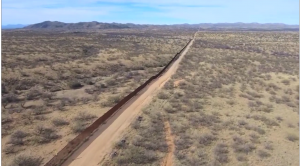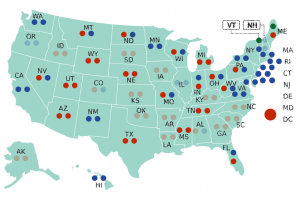By Lauren Gambino
Cronkite News Service
SAN LUIS – U.S. Border Patrol agents Robert Lowry and Mike Espinoza examine a footprint in the sandy road that parallels the U.S.-Mexico border fence south of Yuma.
The 20-foot steel fence casts a large shadow over the road where a Border Patrol vehicle is dragging tires to smooth over the disturbances in the sand. The tactic, called cutting, makes it easier for agents to tell whether someone has thwarted the fence and entered the U.S. illegally.
 “Despite all of the technology we have in the area, it doesn’t replace the agents ability to ‘cut’ and track a footprint,” Lowry said.
“Despite all of the technology we have in the area, it doesn’t replace the agents ability to ‘cut’ and track a footprint,” Lowry said.
As national concern mounts over Arizona’s porous border, the Yuma Sector, its fence and its techniques have received considerable attention from politicians who point to the Border Patrol’s success in securing the region.
Robert Lowry, an agent in the Border Patrol’s Yuma Sector, explains how tires dragged to smooth the sand near the border fence are the best way to determine whether people have crossed illegally.
(Cronkite News Service Photo by Lauren Gambino)
The Border Patrol catches virtually every person who attempts to cross border in this sector, Lowry said. Once a person is captured trying to cross illegally, he or she is prosecuted through the federal court system in Yuma and eventually deported.
The Yuma Sector has managed to significantly reduce crime and illegal border crossings since it increased the number of agents on the border, improved the infrastructure guarding the border and implemented a criminal prosecution initiative known as Operation Streamline, Lowry said.
From 2004 to 2011, the number of agents assigned to the sector has increased from 330 to 969.
Far fewer people attempt to cross here now. The number of people apprehended in the Yuma Sector’s dropped from 138,500 in 2005 to just over 7,000 in 2010, according to Border Patrol statistics.
Sen. Sylvia Allen, R-Snowflake, chairwoman of the Senate Border Security, Federalism and State Sovereignty Committee, asked at a committee meeting why the Tucson sector hasn’t been able to emulate the Yuma sector’s border security.
“The question I want answered is why, if we’ve been successful in the California and the Yuma sectors in stopping the flow of drugs and the flow of human trafficking, why we’re not doing those same procedures down in [the Tucson] sector?” Allen said in an interview.
Allen said she plans to bring this question before Congress.
The Yuma sector comprises a 126-mile stretch of the 1,950-mile U.S.-Mexico border. In comparison, the Tucson border sector is the busiest sector on the Southwest border, covering 262 miles of linear border from the Yuma County line to the Arizona-New Mexico state line.
Secretary of Homeland Security Janet Napolitano discussed the same border security plan for securing the rest of the Southwest border in an interview with Cronkite News Service last week in Washington, D.C.
“[Securing the border] will take a combination of things,” Napolitano said. “It’s going to be technology, it’s going to be manpower and it’s going to be infrastructure.”
On Jan. 14 Napolitano officially pulled the plug on the $1 billion dollar Secure Border Initiative (SBInet) that included building a 700-mile virtual fence along the Southwest border. The virtual fence, a Department of Homeland Security initiative that began in 2006, was long touted as a failure.
“The problem with the SBInet was that it is the wrong kind of technology to be deployed across the entire U.S.-Mexico border,” Napolitano said. “It was too expensive, it was too elaborate and it was not flexible enough to meet the fact that immigration patterns change.”
The completed 53-mile portion of the virtual fence will remain in place; however, the rest of the fence will be constructed with proven and existing technology, Napolitano said.
Bennie Thompson, D-Miss., a member of the House Homeland Security Committee, has been critical of the fence since its inception.
“I am strong proponent of border security, but I’m an even stronger opponent of not wasting taxpayer dollars in the name of border security,” Thompson said. “You can’t spend several hundred million dollars on technology to secure 53 miles of border.”
Thompson said he is hopeful that DHS will work with agents along the border in order to gain an understanding of what security measures each individual sector needs.
Yuma Border Patrol agents Lowry and Espinoza shared a similar sentiment.
“The government must look at what each sector needs individually and that will help with the overall security of the border,” Lowry said. “Each sector is different.”
Key facts about Yuma Sector:
– Stretches 126 miles between the Yuma-Pima County line in Arizona and the Imperial Sand Dunes in California.
– Has three stations located in Yuma and Wellton, Ariz., and Blythe, Calif.
– Has responsibility for Yuma, La Paz and Mojave counties in Arizona, the easternmost areas of Imperial, Riverside and San Bernardino counties in California and the entire state of Nevada.
– Apprehensions dropped from 138,460 in 2005 to just over 7,000 in 2010.
– Agents assigned to the sector grew from 330 in 2004 to 969 in 2011.




